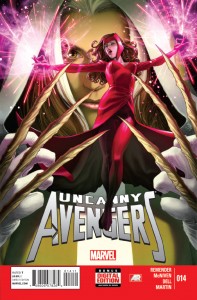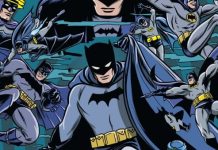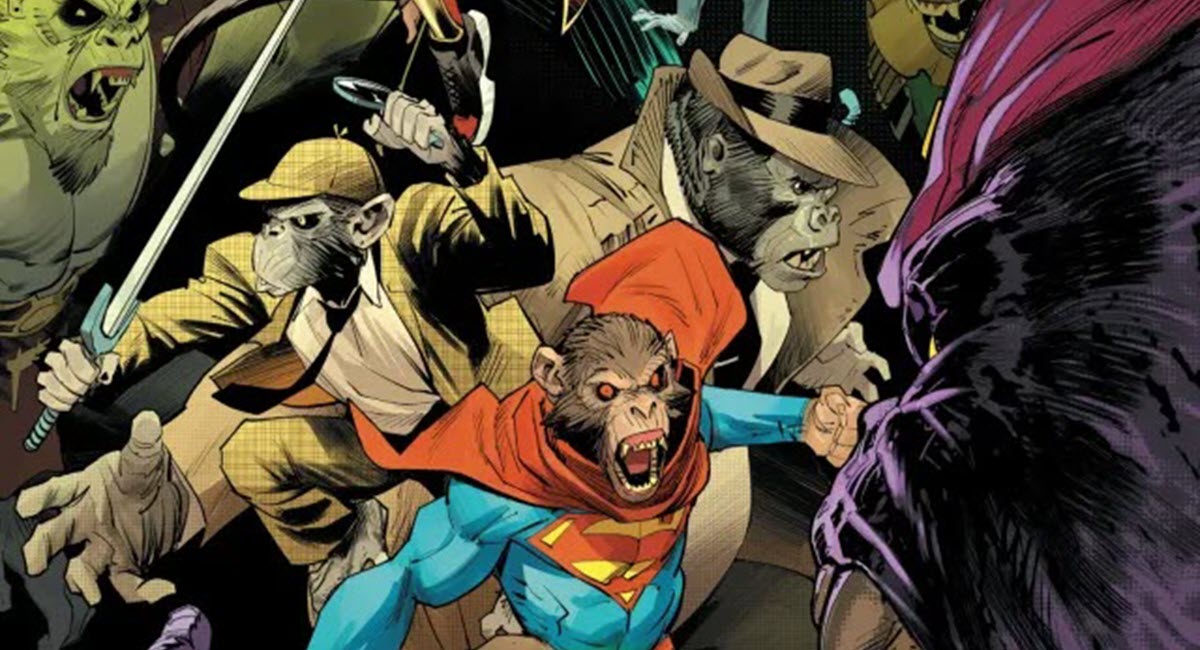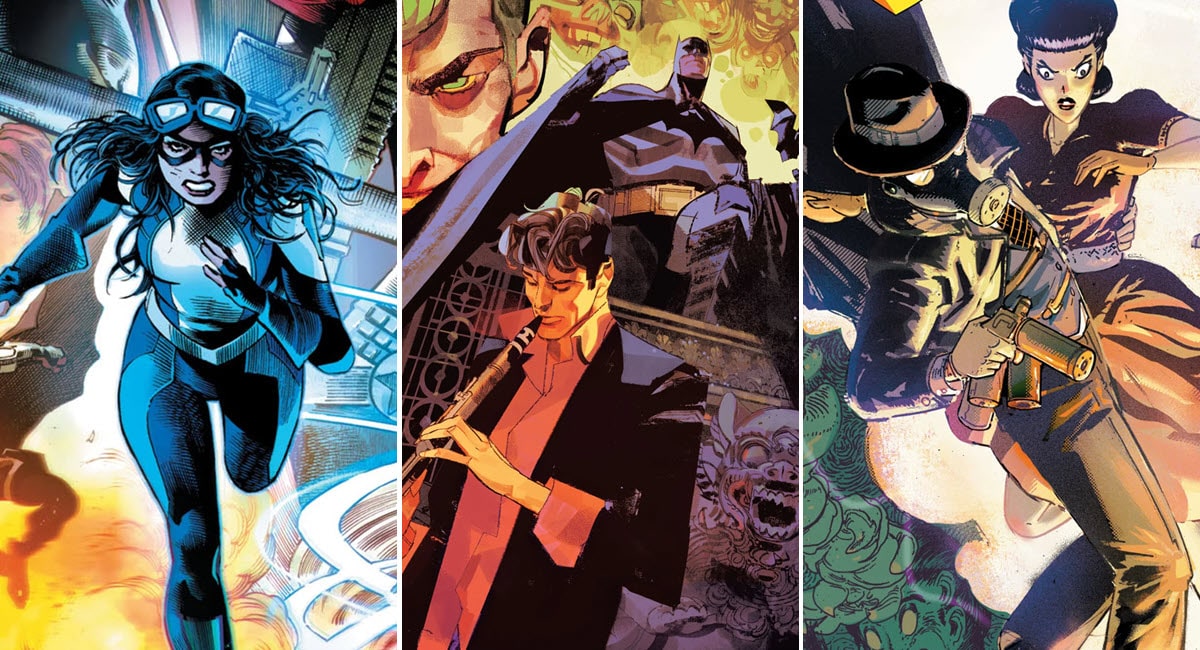By Jeffrey O. Gustafson

It’s unfair to expect creators to bend to my unknowable creative expectations, which is actually a common and slightly inappropriate long-term problem in fandom. Elements of superhero fandom seem to think that they have personal ownership of the characters, that they understand what makes characters work better than the skilled professionals whose job it is to create stories; they take personally the creative changes and outre storytelling risks with which they disagree. I find this attitude frankly repulsive. I’m a big believer in choosing one’s own Continuity – oh, that dirtiest of c-words! – and if I don’t like a story, or how it fits into my own idea of its place in the larger puzzle of the shared universe, I just ignore it. And anyway, I approach stories based more on who’s making it than who’s in it, and I also try a lot of new stuff if I don’t know the creators in question. A creator’s track record makes a difference, and I just don’t like Remender’s track record.
So: Uncanny Avengers. Launched in the wake of the AvX silliness of last summer is Marvel’s go at integrating the X-Men and Avengers franchises. The X-Men, while solidly enmeshed in the larger Marvel Universe, has largely existed in its own corner with its own separate weight of continuity. Uncanny Avengers features a team of various X-Men and Avengers as a public face of human-mutant relations within the Marvel Universe, and also deals with the legacies of both organizations. Remender’s first story is an example of that, featuring Captain America’s nemesis dicking around with X-affairs. His follow-up stories, to the best of my tangential knowledge, features Apacolypse, then timey wimey Kang, with various rotating (and quite good) art teams. As we dive into the story at hand in issue 14, all of these elements seem to be coming together, and it’s somewhat entertaining.
Maybe my experience has benefited by not having to go through the intervening 8-ish issues since I jumped off, cutting to the chase, and it’s one hell of a chase. The issue opens with the somewhat clunky sequence of Kang going through all the previously established alternate-future Marvel Universes and picking up various superheroes for some task or another. There’s Iron Man 2020, Earth-X Spider-Girl, 2099 Doom, and a few others. These opening pages are not addressed again as there are other pressing concerns the height of which conflict we’re thrown into full-on. Something about the Apocalypse twins forcing Wanda Maximoff, The Scarlet Witch, to “rapture” the entire mutant race to their own homeworld, and Wanda’s own efforts to subvert those plans. (Or something. I’m going off the recap page, here, and thank goodness for Marvel’s useful recap pages.) But while Wanda’s spinning her own wheels-within-wheels with the help of C-lister Wonder Man, Rogue and C-lister Sunfire have their own scheme to stop the Scarlett Witch.
And part of Rogue and Sunfire’s plan is revenge. If Uncanny Avengers is dealing with the dueling legacies of the Avengers and the X-Men, the one point where they inextricably came together was House of M. Wanda Maximoff was responsible for the depowering of nearly the entirety of Mutant-kind, and there are many that understandably hold a pretty big grudge. (Mind you, Magneto the Terrorist is free to run around willy nilly instead of rotting in a cell or just plain cold-dead, but chalk my frustration with that up to my general problem with rogue’s galleries – there’s a relevant connection, but that’s a whole other conversation entirely.) Rogue – and I’m going to ignore Sunfire here, though Remender does a decent job of upping her profile in this story – is seeking to stop Wanda from whatever it is she’s doing and to make her pay for M-day in one swell foop, sugah. Remender tries to tie the events of M-day and Wanda’s culpability in that into the fresh wound of Xavier’s death, but I don’t quite buy it. Nevertheless, it gives Rogue a chance to pull out some nifty, visceral tricks in her quest to make Wanda pay. Cue some cool superhero fighting, et cetera and whatnot. Oh, and death. Folks die. Well, superhero-die, which as we all know is meaningless and temporary.
It certainly helps that Steve McNiven (with John Dell and Laura Martin) is on the art. McNiven is a consistently entertaining practitioner of high-quality superhero art, and his stuff expectedly shines here. The combination of McNiven and the epic trans-time scale of the story gives the book an Event feel. I’m defining Event by scale of storytelling, not necessarily in the terms of over-hyped mini-series with countless pointless tie-ins. By my definition, the current “All Out War” story in Walking Dead applies, and so does the story presented here in Uncanny Avengers 14. Big Things Happen Here That Will Change The Marvel Universe Forever!TM including deaths and status quo changes that are bound to be reversed by another writer eventually, but nonetheless will have some lasting impact. I think. It’s still all middle right now. It’s a little refreshing to see such high-impact story in a single unheralded title, but it still has that Eventy tinge of Yet Another Superhero Death. I’m still not a fan of the Apocalypse/Skull/Kang stuff (which is largely minimized here anyway), but what is presented here is straightforward and entertaining enough. That is, if you are a dedicated Marvel fan. Even a Marvel Zombie may find it a stretch to really enjoy this whole thing and it will be completely incomprehensible to the uninitiated.
McNiven’s art carries the story but even McNiven may not be able to save the whole thing when all is said and done. I’m not terribly inclined to keep reading after this nor to catch up on the stuff leading up, and it doesn’t change my view on the quality of Remender’s stuff. Nor am I inclined to really recommend it over, say, any random creator-owned book. But as a standard-fare Marvel superhero book, it’s quite pretty, and if you have an affinity for the characters starring here it will either make you very happy or very, very mad.
And if it upsets you, just ignore it and pick up a better comic.
Jeffrey O. Gustafson is a Brooklyn-based comics blogger and the creator and writer of The Comic Pusher blog at ComicPusher.com








Your writing seems to have a lot of contempt for the material. Why are you reading and reviewing something you don’t seem to enjoy?
The early part of Remenders X-Force run was one of the best things Marvel has done in a long while, fusing the classic Marvel U with Heavy Metal magazine style far-outness and lushness. The first 4 issues of Uncanny Avengers were my least favorite, partially because Cassaday(who i generally love) didn’t mesh with the dark mood of the story, his Havoc looked ridiculous in costume. The issues after that, which you skipped, had amazing art by Danial Acuna, and are all really creative works. Remender pushes boundaries, and sometimes trips himself up, but i deeply appreciate his books as they feel like no others. Your comment about his books being worse than any “random creator-owned book” does seem to suggest you have some personal vendetta. It’s weird of you to say at the least, Remender has written some very highly regarded stuff.
A reviewer isn’t MEANT to only review stuff they enjoy! He was given a comic to review, and I think he did a great job with it. Reviewers aren’t meant to give every issue 10/10.
Was a nice and powerful issue, the storyline is ripe with get out of death cards though, so I doubt anyone will worry – especially considering how almost everyone was killed and restored in Uncanny X-Force, Fantomex even tripled.
I believe there are four life pods bouncing around, the partners with the four death seeds that made their four death horsemen. Rogue might have absorbed healing factor. Wanda’s spell uses the wording “rise”. Kang is plucking a team of heroes from moments before they perish.
I just hope all their returns are cool.
I tried a few issues of UNCANNY AVENGERS, but it was obvious that Remender had a shtick: the heroes get mad at each other and yell. The shtick made the stories unreadable, so I’m not buying the series and don’t seem to be missing anything.
SRS
I gave up on Uncanny X-Men right after the Apocalypse Twins showed up. The whole series just seemed to be too tired into continuity I wasn’t informed about and with too much specificity in that area to ignore. The constant in-fighting (also about things that happened in other books) was also hard to deal with – so your review seems spot on to me. However, what really grabbed my attention was your reference to “choosing your own continuity,” which I am a big proponent of. I call it “macro-closure” (building on McCloud) – I wrote about it here: “No Prize Is Its Own Prize.”
I dropped this book last month when I decided that Remender doesn’t have a very good grasp on these characters. I prefer the characters over creators most of the time and I don’t feel like he’s doing a very good job with this group.
As far as the reviewer/review goes, they fall into two categories for me:
1, The “fanboy” reviewer who follows the books and either likes or dislikes it depending on how they perceive the book should be written or drawn. You can easily find them at your LCS.
2. The “serious” reviewer who prefers independents and Vertigo-style book who tend to also not care for superheroes comics and makes sure to let you know their preferences when they lower their standards to read a superhero comic (especially if published by Marvel or DC). They usually have a blog.
There’s a certain pretentiousness needed to review a comic book and both types serve their purpose IMO. They get people talking about comics.
Very dissappointed with this review. I also dropped Uncanny Avengers because the story wasn’t doing it for me, but a review is different from talking about a book with your buddies at the comic store. Phrases like “patently ridiculous (to be generous)”, saying that a “story was just too stupid for me”, or writing a whole paragraph about how he finds some fanboys attitudes “frankly repulsive” is just amateurish, uninformative and not at all what one would expect from a serious review of the material as presented (not as one would want it to be), or from this site.
Shawn,
I cover some of your concerns in point 1 in the body of my review. As for point 2, that certainly applies to many, but not everyone. On my own blog I cover indie books and mainstream independents and European comics and manga and classics and single issues and a whole lot of superhero books. (This index is handy: http://comicpusher.blogspot.com/p/index.html) Indeed, just an hour after this review went up right here on the Beat I also put up a positive review of Infinity (https://www.comicsbeat.com/infinity6/).
Point 1 could be the Wizard crowd, point 2 could be the Comic Journal Crowd. Many, many of us live in between. (I’ve written about this in the past as well.)
Do you have a direct link to where you’ve written about the “in between”? I’d love to read it.
Osvaldo, The first third of my Superman essay covers this to some degree. http://comicpusher.blogspot.com/2013/06/Superman.html There was also a HU post reply where I expanded on this a little in a more general coverage sense, but I can’t track it down.
Remender’s Marvel work meshes incredibly well with the stories that have come before it. His Uncanny X-Force was the best Marvel published until Daredevil and Hawkeye. And his Uncanny Avengers is pretty much a direct continuation of the themes established in X-Force. He plays with the toys, pulls them out of other stories, and crafts mega-event style plots that pay off over a long run. His stories are separated from other books, allowing the reader to pick up only his book and enjoy it from one month to the next. It is better read as a whole, and sporadically picking up issues to read will leave you missing the big picture. The weakest element of this particular issue was McNiven’s rushed output; the later pages are noticeably lacking his detail and clean lines. Clearly the other artist helped. How about if I ignore this review and read someone else’s.
Thanks for the best blog, I love the way you approach the problem , Do you have a direct link to where you’ve written about the first?
Comments are closed.